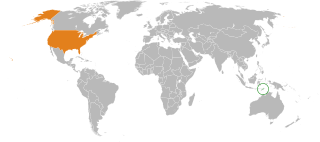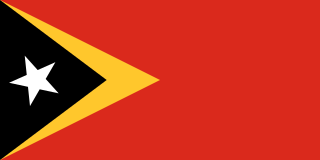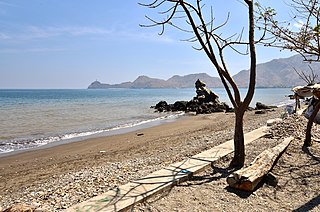Related Research Articles
Aquaculture, also known as aquafarming, is the controlled cultivation ("farming") of aquatic organisms such as fish, crustaceans, mollusks, algae and other organisms of value such as aquatic plants. Aquaculture involves cultivating freshwater, brackish water, and saltwater populations under controlled or semi-natural conditions and can be contrasted with commercial fishing, which is the harvesting of wild fish. Aquaculture is also a practice used for restoring and rehabilitating marine and freshwater ecosystems. Mariculture, commonly known as marine farming, is aquaculture in seawater habitats and lagoons, as opposed to freshwater aquaculture. Pisciculture is a type of aquaculture that consists of fish farming to obtain fish products as food.

Dili is the capital and largest city of East Timor. It lies on the northern coast of the island of Timor, in a small area of flat land hemmed in by mountains. The climate is tropical, with distinct wet and dry seasons. The city has served as the economic hub and chief port of what is now East Timor since its designation as the capital of Portuguese Timor in 1769. It also serves as the capital of the Dili Municipality, which includes some rural subdivisions in addition to the urban ones that make up the city itself. Dili's growing population is relatively youthful, being mostly of working age. The local language is Tetum; however, residents include many internal migrants from other areas of the country.

The political system in Timor-Leste is a unitary semi-presidential representative democratic republic, whereby the Prime Minister of Timor-Leste is the head of government and the President of Timor-Leste functions as head of state. Timor-Leste has a multi-party system. Executive power is exercised by the president and the government. Legislative power is vested in both the government and the National Parliament. The Judiciary is independent of the executive and the legislature. The East Timorese constitution was modelled on that of Portugal, with lesser power given to the president. The country is still in the process of building its administration and governmental institutions. The Economist Intelligence Unit rated East Timor a "flawed democracy" in 2022.

The economy of Timor-Leste is a low-income economy as ranked by the World Bank. It is placed 140th on the Human Development Index, indicating a medium level of human development. 20% of the population is unemployed, and 52.9% live on less than $1.25 a day. About half of the population is illiterate. At 27%, Timor-Leste's urbanisation rate is one of the lowest in the world.

In Timor-Leste, transportation is reduced due to the nation's poverty, poor transportation infrastructure.

After the referendum on independence on 30 August 1999, Timor-Leste became an independent nation on 20 May 2002 and began initiating diplomatic relations with the rest of the global community.

Fishery can mean either the enterprise of raising or harvesting fish and other aquatic life or, more commonly, the site where such enterprise takes place. Commercial fisheries include wild fisheries and fish farms, both in freshwater waterbodies and the oceans. About 500 million people worldwide are economically dependent on fisheries. 171 million tonnes of fish were produced in 2016, but overfishing is an increasing problem, causing declines in some populations.
The culture of Timor-Leste reflects numerous cultural influences, including Portuguese, Roman Catholic, and Malay, on the indigenous Austronesian cultures in Timor-Leste.

The Timor-Leste national football team, recognized as Timor-Leste by FIFA, is the national team of Timor-Leste and is controlled by the Federação de Futebol de Timor-Leste (FFTL). They became a member of FIFA on 12 September 2005.

Bobs Farm is a sparsely populated rural suburb of the Port Stephens local government area in the Hunter Region of New South Wales, Australia. It is on the main road between Newcastle and Nelson Bay and is home to a number of small, boutique style vineyards and wineries and a thriving aquaculture industry. Bobs Farm Public School on Marsh Road is a co-educational government primary school which was established in 1918.

East Timor–United States relations refer to the bilateral relations between East Timor and the United States.

The majority of the population of Timor-Leste is Christian, and the Catholic Church is the dominant religious institution, although it is not formally the state religion. There are also small Protestant and Sunni Muslim communities.

Timor-Leste, also known as East Timor, officially the Democratic Republic of Timor-Leste, is a country in Southeast Asia. It comprises the eastern half of the island of Timor, the exclave of Oecusse on the island's north-western half, and the minor islands of Atauro and Jaco. The western half of the island of Timor is administered by Indonesia. Australia is the country's southern neighbour, separated by the Timor Sea. The country's size is 14,950 square kilometres (5,770 sq mi). Dili, on the north coast of Timor, is its capital and largest city.
This article details the match results and statistics of the Timor-Leste national football team.
The cuisine of Timor-Leste consists of regional popular foods such as pork, fish, basil, tamarind, legumes, maize, rice, root vegetables, and tropical fruit. East Timorese cuisine has influences from Malay and Portuguese dishes from its colonisation by Portugal. Flavours and ingredients from other former Portuguese colonies can be found due to the presence of Portuguese soldiers from other colonies in Timor-Leste.
Life expectancy in East Timor at birth was at 60.7 in 2007. The fertility rate is at six births per woman. Healthy life expectancy at birth was at 55 years in 2007.

Visitors to East Timor must obtain a visa, unless they come from one of the visa exempt countries.

East Timor–Turkey relations are the foreign relations between East Timor and Turkey. The Turkish ambassador in Jakarta, Indonesia is also accredited to East Timor since 2003.

The Bay of Dili is a bay on the north coast of East Timor adjacent to Dili, its capital city. The bay forms part of Ombai Strait, which separates the Alor Archipelago from the islands of Wetar, Atauro, and Timor in the Lesser Sunda Islands.
References
- ↑ "Faculty of Education, Health and Science Newsletter" (PDF). Charles Darwin University. February 2006. Archived from the original (PDF) on 2007-09-18. Retrieved 2009-04-25.
- ↑ Kogan Page (2003). Asia & Pacific Review. World of Information. p. 347. ISBN 0-7494-4063-5.